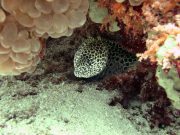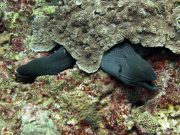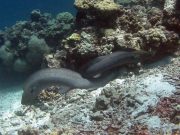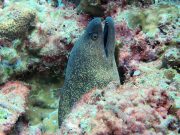Dykning med Moray ål
Lanta Marina Liv | Muraenoidei
Det finns över 200 arter av muränor över hela världen som sträcker sig i storlek från 10 cm till 3 m i längd, med många arter som föredrar att leva i varma tropiska vatten, och flera arter kan hittas när du dyker runt Koh Lanta.
Muränor gömmer sig ofta i revsprickor mellan stenar, bråte och hårdkoraller med bara huvudet utstickande. Vissa arter av muränor älskar att bosätta sig inuti gigantiska tunnsvampar.
Även om muränor har ett ormliknande utseende är de inte reptiler utan fiskar som ständigt öppnar och stänger munnen för att cirkulera vatten genom gälarna, som sitter en bra bit bakom huvudet.
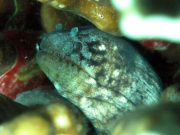
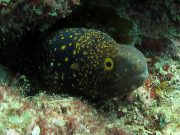

Den tjocka huden är slät, täckt av ett skyddande slem och är ofta mönstrad. En distinkt ryggfena löper från huvudet till stjärten.
Muränan har små ögon och dålig syn och använder luktsinnet för att upptäcka byten som fiskar, krabbor och bläckfiskar, som fångas med hjälp av ett överraskningsmoment.
Eftersom käken är ganska liten krossas större byten först genom att kroppen lindas runt offret och krossas tills det är tillräckligt platt för att kunna ätas.
När offret har gripits av framtänderna startar en unik andra mindre käke inuti halsen, kallad 'svalgkäken', som sliter sönder och transporterar den fångade födan till halsen och matsmältningssystemet.
I filmen 'Alien' från 1979 visades en fiktiv utomjordisk art som använde en svalgkäft för att attackera sina offer.
På dykplatserna kan man ibland se muränor som parar sig. De lindar sina kroppar runt varandra och lägger och befruktar över 5.000 ägg åt gången.
När moray eel-larverna kläcks flyter de ut i det öppna havet och lever bland plankton nära ytan i över 8 månader tills de blir tillräckligt stora för att våga sig tillbaka till revet.
8 arter finns på denna sida:
- Blackspotted Moray (Gymnothorax favagineus)
- Giant Moray (Gymnothorax javanicus)
- White-Eyed Moray (Gymnothorax thyrsoideus)
- Yellow-edged Moray (Gymnothorax flavimarginatus)
- Zebra Moray (Gymnomuraena zebra)
- Snowflake Moray (Echidna nebulosa)
- Fimbriated Moray (Gymnothorax fimbriatus)
- Barred Snake Moray (Uropterygius fasciolatus)
Blackspotted Moray
(Gymnothorax favagineus)
The blackspotted moray (Gymnothorax favagineus), also known as the honeycomb moray, is a large eel which can grow up to 3m long, however most individuals are significantly smaller than this.
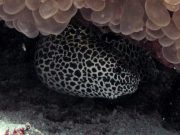
Gymnothorax favagineus @ Koh Haa
This moray is white with brown/black blotches and spaces, sometimes forming a honeycomb pattern. The blotches vary between individuals and size and depend on the eel's habitat. Those found in clear coral reefs usually have less black than those found in turbid waters.
The blackspotted moray lives on the outer slopes of coral reefs. During the day, it sits sheltered in crevices and at night it leaves its lair to actively hunt its prey along the reef. It feeds mainly on small fish and cephalopods.
Giant Moray
(Gymnothorax javanicus)
At up to 3m long, and weighing up to 30kg, in terms of body mass, the giant moray is the largest moray eel.
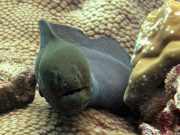
Gymnothorax javanicus @ Koh Haa
The giant moray feeds mainly on fishes and occasionally on crustaceans, and due to its position at the top of the reef's food chain, this eel is often ciguatoxic - the moray can absorb and store toxins from other reef fish in its body fat, and is poisonous if eaten by humans.
The body is deep with a strongly tapered tail and has a greyish, brownish background color, with juveniles being lighter in color. Black around the gill opening. Adults have black specks on the head that resemble leopard spots further back on the body.
The giant moray has several large sharp canines on both the upper and lower jaw alongside rows of smaller, sharp teeth.
Will attack humans if provoked, and sometimes just for fun.
White-Eyed Moray
(Gymnothorax thyrsoideus)
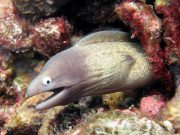
Gymnothorax thyrsoideus @ Anemone Reef
The white-eyed moray is a medium-sized fish which can grow up to 65cm, but is most usually found around 35 - 45cm. The head is grey with distinctive white eyes.
The body is serpentine in shape, speckled with small dark spots, and has an overall pale brownish/beige color that can vary in strength between different eels.
This eel can often be found sharing its nook or cranny with other moray eels, and sometimes groups of 3 - 5 white-eyed moray can be found together.
The white-eyed moray feeds on crustaceans, small fishes and octopus.
Yellow-edged Moray
(Gymnothorax flavimarginatus)
The yellow-edged moray is similar to the giant moray, but slightly smaller, with a maximum length of around 2.4m.
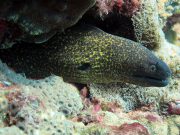
Gymnothorax flavimarginatus @ Koh Haa
This moray is yellowish with a densely mottled dark brown pattern and orange(ish) eyes. The head is a purplish-grey colour, and the end of the tail has a yellow margin. This moray also has black blotches at the gill openings.
Eats fish, including poisonous fish such as lionfish, crustaceans and possibly octopus.
Zebra Moray
(Gymnomuraena zebra)
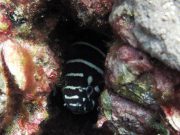
Gymnomuraena zebra @ Koh Haa
The zebra moray eel is a tan to dark brown moray with irregular close-set narrow white to pale yellow bars or bands, giving rise to its common name.
Even though the zebra moray can reach lengths of up to 1.5m, it is more usually observed around 45 - 55cm.
Gymnomuraena zebra actively hunt their prey at night, and unlike other moray eels, they feed almost exclusively on crustaceans, sea urchins and mollusks.
This eel has a short snout and close-set pebble-like teeth used for crushing hard-shelled prey. Totally harmless to humans.
Snowflake Moray
(Echidna nebulosa)
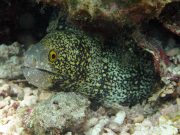
Echidna nebulosa @ Koh Haa
The snowflake moray has a pale body, generally yellowish/white, with rows of black blotches/bands, yellow eyes and yellow front nostrils.
Reaching up to 1m long, this moray is more usually observed in with 50 - 70cm range.
This moray feeds both during the day, and at night, with shrimp, crabs or lobsters (crustaceans) being their natural diet.
As with other moray eels, their eyesight is modest, compensated by a perfect sense of smell, thanks to two anterior nostrils and two posterior ones shaped like a small tube. The front nostrils point downwards, at the extremity of the snout, and the second ones upwards, at the level of the eye. These nostrils form a sort of all-round smelling radar for hunting, both during the day, and at night.
Completely harmless to humans.
Fimbriated Moray
(Gymnothorax fimbriatus)
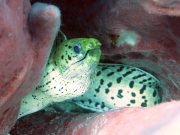
Gymnothorax fimbriatus @ Koh Haa
The Fimbriated Moray is a medium sized Moray with a light body color, often whitish, cream or light/pale brown.
The body is covered in many dark spots and blotches which vary with age. These dark spots and blotches are often in small groupings or rows.
The head is yellowish or pale greenish with dark spots and blotches. The mouth is white inside, also with many small black spots.
The Fimbriated Moray grows up to 80 cm and is usually hidden during the day, preferring to feed at night on small fish and crustaceans.
Barred Snake Moray
(Uropterygius fasciolatus)
Main body colour ranges from pale to dark grey with dark bars along the main body. Both upper and lower jaws with rows of fine, sharp teeth. Dark lines behind the eyes. Large secondary nostrils above the eyes.
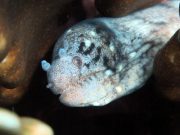
Uropterygius fasciolatus @ Koh Haa
Found in shallow reefs at depths between 1 and 8m. Hides during daytime and hunts prey during evening hours when it feeds mainly on smaller fish and crustaceans.
This is a very uncommon species and rare to find in the eastern Indian Ocean.
Dykning med Moray ål runt Koh Lanta
Dykning och Snorkelutflykter
Om du vill ha en chans att se Moray ål på en av våra dagliga högsäsongs dykresor från Koh Lanta, skicka oss ett e-postmeddelande till info@diveandrelax.com.
Följ med på våra dykresor med speedboat under högsäsong till några av Thailands bästa dykplatser och njut av små grupper, korta restider och fokus på personlig service, säkerhet och nöje.
Är du ännu inte certifierad dykare? Lär dig att dyka på Koh Lanta med den 3-dagars SSI Open Water Diver-kursen.
Boka online och spara 10 % på dykresor och dykkurser på Koh Lanta.
Ta Reda på Mer
Guider för Marina Djur och Växter i Indo-Stilla Havet
- Allen, G., Steene, R., Humann, P., DeLoach, N. (2003) Reef Fish Identification, Tropical Pacific. Jacksonville, FL., USA: New World Publications, Inc., ISBN 1-878348-36-1.
- Humann, P., DeLoach, N., (2010) Reef Creature Identification, Tropical Pacific. Jacksonville, FL., USA: New World Publications Inc., ISBN 978-1-878348-44-9
- Debelius, H. (2013) Indian Ocean Reef Guide. Frankfurt, Germany: IKAN - Unterwasserarchiv, ISBN 978-3-939767-52-7.
- Debelius, H. (2004) Nudibranchs and Sea Snails, Indo-Pacific Field Guide. Frankfurt, Germany: IKAN - Unterwasserarchiv, ISBN 3-925919-51-1
- Erhardt, H., Knop, D. (2015) Corals Indo-Pacific Field Guide. Frankfurt, Germany: IKAN - Unterwasserarchiv, ISBN 3-925919-69-4.
- Veron J.E.N., Stafford-Smith M.G., Turak E. and DeVantier L.M. (2016). Corals of the World




